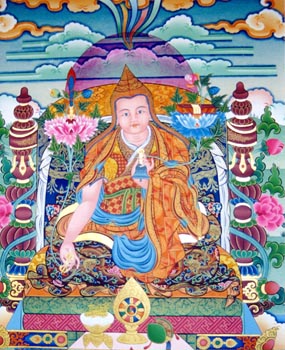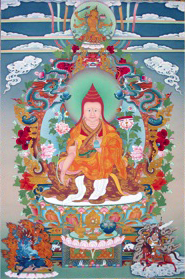Mipham Rinpoche
འཇུ་མི་ཕམ་རིན་པོ་ཆེ་
'ju mi pham rin po che
Jamgon Mipham Namgyal Gyatso
འཇམ་མགོན་མི་ཕམ་རྣམ་རྒྱལ་རྒྱ་མཚོ་
'jam mgon mi pham rnam rgyal rgya mtsho
Short Biography
- Repository of the four aspects of perfect intelligence,
- Lord of the kingdom of dharma,
- You were the greatest pandita of your generation:
- Homage to Jamgon Mipham.
Jamyang Mipham Namgyal Gyatso Rinpoche (1846-1912) ranks alongside Longchen Rabjam and Tsongkhapa as one of Tibet's most prolific and influential masters. His presentation of the Nyingma School's unique approach to the view and practice of Buddhism, and in particular the relationship between Madhyamaka and the Great Perfection, has had an enormous impact on the past few generations of Tibetan Buddhist scholars and practitioners. Namdrolling Monastic College, currently the largest functioning Nyingma educational institution, includes twenty of his texts in its curriculum. By comparison, only five texts by Longchenpa are included and only one by Rongzom Mahapandita.
Mipham's primary teachers were Patrul Rinpoche and Jamyang Khyentse Wangpo, both incarnations of the tertön Rigdzin Jigme Lingpa. Khyentsé Rinpoche requested Mipham to preserve the Nyingma teachings through teaching, debate, and composition—a task in which he admirably succeeded. About his remarkable student, Khyentsé remarked: “In this time, there is no one else on earth more learned than Lama Mipham.”
He excelled not only in study and teaching, however, but in practice as well. The numerous retreats he completed were always accompanied by miraculous signs of accomplishment.
Mipham Rinpoche’s collected writings comprise twenty-seven volumes and cover a vast array of topics. Among his most influential writings are The Speech of Delight—a commentary on Shantarakshita's Ornament of the Middle Way, Gateway to Knowledge—which provides an overview of the Buddha’s teachings, and Beacon of Certainty—an elucidation of the view of the Great Perfection and its relationship to the Middle Way teachings.
Mipham’s most important students were Dodrupchen Rinpoche, the Fifth Dzogchen Rinpoche, Gemang Kyabgon, Khenpo Padmavajra, Palyul Gyaltrul, Karma Yangtrul, Palpung Situ Rinpoche, Ling Jetrung, Adzom Drukpa, Tokden Shakya Shri, Ngor Ponlob, and others. The great tulkus of Sechen Monastery, Dzogchen Monastery, Kathok Monastery, Palyul Monastery, Palpung Monastery, Dege Gonchen, Repkong and others of all lineages, Sakya, Gelug, Kagyu, and Nyingma, all became his disciples.
Jamgon Mipham Rinpoche was also instrumental in training some of last century’s most important Nyingma teachers. His most prominent students include Khenpo Kunpal, Katok Situ, Sechen Rabjam Rinpoche, Khenpo Pema Dorje, and the terton Lerab Lingpa.
Literary Works
Main Teachers
Main Students
- Khenpo Kunpal
- Kathok Situ Rinpoche
- Shechen Gyaltsap
- Shechen Rabjam
- Lerab Lingpa
- Khenpo Shenga
- Lagla Sonam Chodrub
- Troshul Khenpo Jampal Dorje
Main Lineages
Alternate Names & Spellings
- Lama Mipham Chokle Namgyel - (bla ma mi pham rnam rgyal rgya mtsho)
- Jamgön Mipham Rinpoche - ('jam mgon mi pham rin po che)
- Mipham Jamyang Gyamtso - (mi pham 'jam dbyangs rgya mtsho)
- Jampal Gyepe Dorje - ('jam dpal dgyes pa'i rdo rje)
- Mipham Gyatso - (mi pham rgya mtsho)
- Lama Mipham - (bla ma mi pham)
- Jampal Dorje - ('jam dpal rdo rje)
- Ju Mipham - ('ju mi pham)
- Jñanasara
- Ajita
Other Reference Sources
- Biographies: The Life of Mipham Jamyang Namgyal (1846–1912)
- The Life and Works of Mipham Rinpoche
- Mipham Rinpoche Timeline
- Mipham's commentary on the Shambhala sections of the Kalachakra Tantra[1]
- Mipham Rinpoche's The Sword of Knowledge with Khenchen Palden Sherab's commentary The Blazing Lights of the Sun and Moon[2]
- "Molten Gold" The Pith Instruction on Looking Into the Mind; A Guide to the Mind entitled Liquid Gold Vomited from the Stomach of a Dog[3]
- The Meaning Of The Vajra Seven Line Prayer To Guru Rinpoche[4]
- Instruction on Attaining Inner Calm[5]
- The Teaching of the Essential Point in Three Words[6]
- The Lion's Roar Proclaiming Extrinsic Emptiness by Mipham Rinpoche[7]
- Douglas Duckworth, Mipam on Buddha-Nature. The Ground of the Nyingma Tradition, State University of New York Press, 2008. ISBN 978-0-7914-7521-8. The translation is contained in Appendix 1.
- Douglas Duckworth, "Distinguishing the Views and Philosophies, Illuminating Emptiness in a Twentieth-Century Tibetan Buddhist Classic" - State University of New York Press, 2011. ISBN 978-1-4384-3437-7. Commentary on Mipham's Beacon of Certainty.
- From: Rigpa Shedra:
- The Lion's Roar: A Commentary on Sugatagarbha - Khenpo Namdrol's audio-commentary for Rigpa Shedra East podcast[8]
- Mipham's "Lion's Roar: Buddha Nature in a Nutshell" Translated by Gyurmé Avertin based on Khenpo Namdrol Rinpoche’s teachings[9]
- Mipham Rinpoche's commentary on the Uttaratantra Shastra - Khenpo Dawa Paljor's audio-commentary for Rigpa Shedra East podcast[10]
- From: Orgyen Khamdroling Shedra:
- "Journey to Certainty" The Quintessence of the Dzogchen View; An Exploration of Mipham’s Beacon of Certainty - Anyen Rinpoche Translated and edited by Allison Graboski, Wisdom Publications forthcoming {late 2011-early 2012 this book is Outright Amazing BL}
- Also at Anyen Rinpoche's website you can get recordings and transcriptions from his Orgyen Khamdroling Shedra series'; Mipham's "Beacon of Certainty" and Mipham's "“Great Lion’s Roar; [An] Exposition on the Buddha-nature"[11]
- Forthcoming {late 2012-early 2013} Anyen Rinpoche and Allison Graboski's translation of Khenpo Kunpal's very important commentary to Mipham’s Beacon of Certainty.
Internal Links
- The Buddha's 80 Minor Marks explained by Mipham Rinpoche
- Commentary on the "Seven-lined Supplication to the Guru" Wylie text
- Commentary to "The Supplication of the Vajra Verse" Wylie text
- bde gshegs snying po'i stong thun chen mo seng ge'i nga ro
External Links
- Cataloged Writings of Mipham at TBRC
- Mipham Rinpoche Series on Lotsawa House
- homepage of the 3rd Jamgon Mipham Rinpoche
- Mipham Yahoo group
- Outline: Ju Mipham Sungbum / Mipham Karchag
- Mipham Jamyang Gyatso at Wikipedia
- Translations of Mipham text by Bodhicitta Sangha
- A online copy of nges shes sgron me in Unicode Tibetan.[12]
This page was developed by the Rimé Foundation

